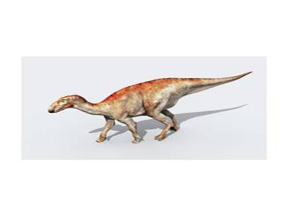
Mantellisaurus Dinosaur is a genus of dinosaur that belongs to the group of herbivorous dinosaurs known as ornithopods. It lived during the Early Cretaceous period, approximately 125 million years ago. The name "Mantellisaurus" honors Gideon Mantell, a pioneering paleontologist who discovered several important dinosaur species in the early 19th century. Mantellisaurus was a medium-sized dinosaur, measuring about 5 to 6 meters (16 to 20 feet) in length. It had a bipedal stance, meaning it walked on its hind legs, and it had relatively long hind limbs, which would have allowed it to move swiftly and efficiently.
Its forelimbs were shorter and less developed, suggesting that they were not used for locomotion but rather for manipulating vegetation or other objects. One of the distinctive features of Mantellisaurus was its head. The body of Mantellisaurus was relatively slender and lightweight. It had a flexible tail that may have aided in balance and agility. Its skeletal structure suggests that Mantellisaurus was a swift runner, enabling it to escape from predators or quickly reach new feeding grounds.
Mantellisaurus Facts :
| Name: | Mantellisaurus Dinosaurs |
| Size: | 5-6 meters |
| Main Facts: | Mantellisaurus is a genus of dinosaur that belongs to the group of herbivorous dinosaurs known as ornithopods. It lived during the Early Cretaceous period, approximately 125 million years ago. |
As for its appearance, Mantellisaurus likely had a combination of scales and feathers. While direct fossil evidence of feathers in Mantellisaurus is lacking, the presence of feathers in other closely related dinosaurs suggests that it is reasonable to assume that Mantellisaurus had at least some feather covering. These feathers may have served various purposes, such as insulation, display, or even limited flight capabilities in some of its ancestors.
Overall, Mantellisaurus was a fascinating dinosaur of the Early Cretaceous period. Its herbivorous diet, swift movement, and potential feathered appearance make it an intriguing subject for paleontologists studying the evolution and diversity of dinosaurs. Further discoveries and research will continue to shed light on this remarkable creature and its place in prehistoric ecosystems.